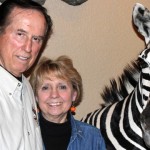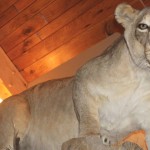Iola’s Hetzer has hunted around the world
By Greg Seubert

African safari?
Been there, done that.
Brown bear hunting in Russia?
Uh-huh.
Mountain goat hunting in New Zealand?
Check.
Take a step into Gary Hetzer’s den and it’s easy to see the rural Iola man is no ordinary hunter.
The room is filled with taxidermy mounts from Hetzer’s hunts that have also included trips over the years to South America and Europe.
The centerpiece mount is a 16-foot-high giraffe that Hetzer shot in 2012 on a trip to South Africa.
“Everybody’s in awe,” he said. “I make women close their eyes. The other day, there was a gal in here and I made her look up. ‘Holy man, is that ever intimidating,’ she said. Her husband said, ‘You know, I’ve seen giraffes, but never knew they were that large.”
It took more than two years since that hunt for Hetzer to receive his nine mounts from the trip. He also shot a zebra, lion and six other animals.
A taxidermist in Philadelphia, Penn., prepared the mounts and Hetzer hired a company, Trophy Transports, to deliver the mounts last September. His son and daughter-in-law, Todd and Casey Hetzer, who accompanied Hetzer on the trip, also had their 10 mounts delivered to their Milwaukee area home.
Hetzer arranged to have the taxidermist do the work after the animals arrived in New York.
“It took awhile to get them out of Africa,” he said. “I think they were dragging their feet because I didn’t have them mounted there. Why would I want to have them mounted there when I don’t know the quality I’m going to get? First, they went to New York and you have to have somebody get them out of New York. You have to have a broker. If you have a taxidermist that knows how to do that, he can get through that. It’s time-consuming.”
Learning to hunt
Hetzer took his first hunting trip near his hometown of Milwaukee.
“That was with my dad and an older gentleman,” he said. “I think I was 15. The first gun I bought was a .30-30 rifle. The next year, I bought a shotgun that I could shoot slugs with and Dad used a rifle. He only hunted for a couple years because he could only walk short distances. That kind of stopped, but I had friends that hunted and we went up north.”
He recalled living with his aunt and uncle as a child in Manitowish Waters.
“That was deer hunting country in those days,” he said. “I had a rack there that my dad had shot in 1946 and it still had the tag on it. I was along with him when he shot it. A deer came walking along the trail and I was pretty hooked.”
Hetzer’s been hooked ever since.
“This morning, I was out hunting,” Hetzer said in the home he shares with his wife, Linda, a few miles east of Iola on State Highway 161.
“The wind wasn’t blowing, it was so quiet and all the animals were running around,” he said. “If you’re a hunter, you’re looking back and forth all the time so you can see the animal as quick as you can. As the years went by, I wanted to get bigger and better animals. It started with small game – squirrels and rabbits – and I worked my way up to big rifles.
“It had to be something large before I would shoot it,” he added. “I’ll let 10, 12, 15 animals go by before I see one that I’ll shoot. The bigger one you get, the more you feel that you outsmarted him. That’s half the battle.”
World traveler
Hetzer eventually began traveling the world for that special hunting experience.
Those trips include a bear hunt to Russia in 2000.
“That was probably one of the neatest experiences,” Hetzer said. “We started out in Anchorage and flew across and landed in Russia. When we landed there, it was the middle of nowhere. There was a dilapidated building and 12 soldiers with guns came out and stood around the plane.
“They had a van bus and it was about a nine-hour drive,” he said. “They hauled us to a gravel pit and there were two helicopters there and a very small building. They threw so much stuff in it I wondered if it was going to ever take off. As you fly, it’s almost like flying on the moon. You see nothing but snow, snow, snow. When we got close to where we were going, I saw a set of tracks from an Russian Army tank. The tank was hollowed out on the inside and had benches to sit on. It had a wood furnace. It was kind of a nice lodge. They took us out every day on snowmobiles and pulled us on a box sled.”
Hetzer eventually shot a bear that can now be found in his living room.
“This bear happened to go down to a swollen stream that was really rushing,” he said. “We stopped several times to find him. I saw him way off walking along a mountain. It was about a 400-yard shot. He spun around and started sliding. I picked up my camera and took a picture of him sliding. The first thing they do is take out the gall bladder. They sell that as an aphrodisiac. That year, I went to New Mexico for (mountain) lion. I came home and 10 days later, I went to Africa. I went to Russia for the bear and Montana for elk. That was quite a year. I think I pulled it off because I took the family to Africa with me.”
Hetzer also has a mount of a thar, a mountain goat, from a trip to New Zealand.
“They multiply like crazy because they have no enemies,” he said. “They were brought there from the Himalayas. In New Zealand, there were no mammals on those islands before humans came, not even a mouse. Anything you raise there, you have to have a fence around it because the animals will come and eat their whole crop.”
Hetzer and his family traveled to Africa for a photo safari in 2000, but he knew he wanted to return there to hunt.
He got his chance and headed to South Africa in 2012 with Todd and Casey.
“Everything is fenced in South Africa,” he said. “If they don’t fence it, the natives will kill (animals) or take the horns off the rhinos. You have to patrol it or the natives will kill everything. Instead of raising cows and selling beef, they raise animals to be hunted. They take the meat and sell the meat. All these animals were skinned and the meat was sold.”
The giraffe hunt was a highlight of the trip, Hetzer said.
“I was with a guide and I spotted it,” he said. “When you look for deer, you’re looking in the woods. When you look for these, you’re looking for ducks. They’re so awesome when you first see them. They can see so far, so they’ll never let you get close. They’ll start moving away.
“The guide said, ‘You think you can shoot that thing from here?’” he said. “Just the head and part of the neck was sticking out. I said, ‘I’ve shot from a lot further than that.’ He went right down. I’ve never seen anyone knock one down with one shot. It weighed 5,000 pounds. They came with a truck and trailer and this fellow wanted to put a strap around its neck. The guide said, ‘Be careful, it can kill you.’ That thing took its foot and it just missed his head.”
Todd accompanies his father on most of the trips.
“We get an idea and we pursue it,” Hetzer said. “We usually hook up with a guide that starts sending you paperwork on what to do. I talk to people and they’ll say, ‘Oh, you should go with this guy.’ That’s how I went to Russia. A guy said, ‘Hey, I’m going, would you like to go along?’ When I went to Russia, I met a guy and he said, ‘Well, how about going to South America with me?’”
Hetzer’s hunting adventures have taken him to Canada, Africa, Alaska, Mexico, New Zealand, South America, Asia, Europe.
Although he had to wait two years go get his mounts, he said it was worth it.
“I was really pleased because I knew (the taxidermist’s) quality,” he said. “If you look at their eyes, their eyes look like they’re alive,” he said. “Each one has a little different turn and they’re looking in different directions.
“Everything was perfect,” he added. “They were far better than I expected.”


